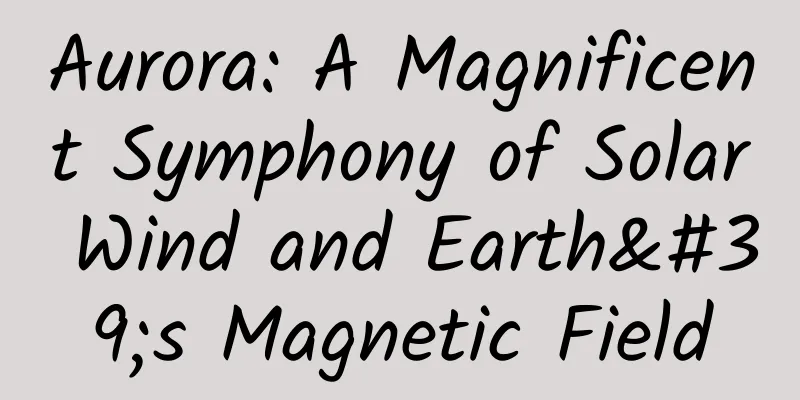Aurora: A Magnificent Symphony of Solar Wind and Earth's Magnetic Field

|
Aurora is a colorful plasma phenomenon that occurs when charged particles from the sun (solar wind) enter the Earth's magnetic field and collide with atoms and molecules in the atmosphere in the high altitudes near the Earth's North and South Poles, thus emitting beautiful light. It is called the Southern Lights in the South Pole and the Northern Lights in the North Pole. 1. The mechanism of aurora generation There are three necessary conditions for the generation of auroras: atmosphere, magnetic field and high-energy charged particles. None of these three is indispensable. The atmosphere provides luminous matter, the magnetic field provides a channel to guide charged particles, and high-energy charged particles provide energy to excite the atmosphere to glow. 1.1 Atmosphere The Earth's atmosphere is composed of gases of different compositions and densities, the most important of which are nitrogen and oxygen. Atmospheres at different altitudes are exposed to different degrees of solar radiation, and therefore have different temperatures and degrees of ionization. The atmospheric layer near the Earth's surface is called the troposphere. The temperature decreases with altitude, reaching its lowest point (-60°C) at about 10 kilometers. Above the troposphere is the stratosphere, where temperature increases with altitude, reaching its highest point (0°C) at about 50 kilometers. Above the stratosphere is the mesosphere, where the temperature decreases with altitude, reaching its lowest point (-90°C) at about 80 kilometers. Above the mesosphere is the thermosphere, where the temperature increases with altitude, reaching its highest point (1000°C) at about 500 kilometers. Above the thermosphere is the exosphere, which is farther from the center of the earth and less affected by the earth's gravity, so the large gas particles in this layer often escape into outer space. The atmospheric density is extremely low and is not much different from outer space. Because the thermosphere is subjected to strong solar ultraviolet and X-ray radiation, the atoms and molecules in it are ionized into positive and negative ions and free electrons, forming the ionosphere. The ionosphere has the characteristic of reflecting radio waves, which plays an important role in radio communications. Auroras mainly appear in the thermosphere because there are enough atoms and molecules that can be excited to emit light, and the density and pressure are low enough that excited atoms and molecules are not easy to lose energy through collisions. Auroras generally appear in the altitude range of 80-500 kilometers. 1.2 Magnetic Field The Earth is a huge magnet with a complex and dynamic magnetic field inside. The Earth's magnetic field can be roughly regarded as a dipole magnet, with a south pole and a north pole at the center of the Earth. They do not coincide with the geographic north and south poles, but have a certain inclination and offset. The strength and direction of the Earth's magnetic field vary with location and time, but generally speaking, the strength of the Earth's magnetic field is weakest at the equator (about 0.3 Gauss) and strongest at the poles (about 0.6 Gauss). The external shape of the Earth's magnetic field can be roughly regarded as an ellipsoid composed of magnetic lines of force. This ellipsoid is compressed on the side of the sun and elongated on the side away from the sun, forming a magnetic tail. This is because the Earth's magnetic field is affected by the solar wind, which is a stream of charged particles that is continuously ejected from the solar atmosphere. It is mainly composed of electrons and protons, with a speed of about 400-800 kilometers per second, a density of about 5-10 particles/cubic centimeter, a temperature of about 100,000-2 million Kelvin, and a magnetic field strength of about 2-5nT. The interaction between the solar wind and the Earth's magnetic field forms a complex and dynamic structure called the Earth's magnetosphere. The Earth's magnetosphere can be divided into several regions: bow shock, magnetosphere front, magnetosheath, magnetotail, plasma sheet, plasmasphere, plasma beam, etc. Various physical phenomena exist in these regions, such as electric current, electric field, wave motion, particle acceleration, energy conversion, etc. The Earth's magnetic field guides and captures charged particles in the solar wind. Some of the charged particles are bounced back into space by the Earth's magnetic field, forming the Van Allen radiation belts; others follow the Earth's magnetic field lines into the polar atmosphere, forming the aurora. 1.3 High-energy charged particles The energy of the aurora comes from high-energy charged particles in the solar wind, mainly electrons and protons. These charged particles need to go through several steps before entering the Earth's atmosphere: first, they need to be extracted from the solar wind; second, they need to be accelerated to a high enough energy; finally, they need to fall along the Earth's magnetic field lines to the polar atmosphere. The process of extracting charged particles from the solar wind occurs primarily in several regions of the Earth's magnetosphere: the bow shock, magnetosheath, plasma sheet, and plasmasphere. In these regions, the interaction between the solar wind and the Earth's magnetic field generates various instabilities and fluctuations that cause the charged particles in the solar wind to exchange and mix with the charged particles in the Earth's magnetosphere. The process of accelerating charged particles mainly occurs in two regions of the Earth's magnetosphere: the plasmasphere and the magnetotail. In the plasmasphere, due to factors such as diurnal effects and coronal mass ejections (CMEs), circular currents and circular electric fields are generated, causing charged particles to move along circular orbits and be subject to effects such as radial drift and resonance resonance, thereby increasing their energy. In the magnetotail, due to the compression of the solar wind and the distortion of the magnetosphere, phenomena such as magnetic reconnection and plasma sheet separation occur, causing charged particles to obtain huge acceleration and be transmitted along magnetic field lines toward the Earth's poles. The process of descending along the Earth's magnetic field lines to the polar atmosphere mainly occurs in the aurora region and the polar cap region. In the aurora region, due to the quasi-dipole nature of the Earth's magnetic field, the angle between the magnetic field lines and the ground plane is small, and charged particles can enter the atmosphere more easily. In the polar cap region, due to the deviation of the Earth's magnetic field, the angle between the magnetic field lines and the ground plane is large, and charged particles need to pass through stronger electric fields or fluctuations to enter the atmosphere. When high-energy charged particles enter the atmosphere, they collide with atoms and molecules in the atmosphere, causing them to emit light. 2. The shape and color of the aurora Auroras have a variety of shapes and colors, which depend on factors such as the energy, density, distribution, and direction of charged particles, the strength, direction, and change of the magnetic field, and the composition, density, temperature, and pressure of the atmosphere. The shapes and colors of auroras also change over time and space, presenting a variety of shapes and colors that are extremely gorgeous. 2.1 Morphology Auroras can be divided into the following types according to their morphology: Uniform arc aurora: This is the most common and simplest form of aurora, appearing as one or more arc-shaped bright bands parallel to the horizon, usually stationary or slowly moving, and light green or light red in color. Ray-type light column aurora: This is a more complex and spectacular form of aurora, appearing as one or more slender bright columns extending upward from the horizon, usually fast-moving or flashing, and in colors such as green, red, and purple. Ray-type arc-band aurora: This is a type of aurora between the first two, appearing as one or more arc-shaped bright bands with ray-like structures. They usually move or change slowly, and their colors are green, red, purple, etc. Curtain Aurora: This is the most exciting and complex aurora form, appearing as one or more bright bands hanging vertically in the sky like a curtain, usually changing or flashing rapidly, with colors such as green, red, and purple. There are many tiny rays or stripes on the bright bands of the curtain aurora, showing rich details and layers. Curtain Aurora appears when the aurora activity is the strongest, and is also the aurora form that attracts people's attention the most. 2.2 Color The color of the aurora depends on the type and energy level of the atmospheric atoms or molecules that are excited to emit light, as well as the human eye's perception of different wavelengths of light. Generally speaking, the colors of the aurora are as follows: Green: The most common and brightest auroral color, green is caused primarily by light emitted by oxygen atoms at a wavelength of 557.7 nanometers. This light requires less energy and therefore appears at lower altitudes (about 100-250 kilometers). Red: This is the second most common and fainter aurora color, mainly caused by the light emitted by oxygen atoms at a wavelength of 630.0 nanometers. This light requires higher energy, so it appears at higher altitudes (about 200-500 kilometers). In addition, the light emitted by nitrogen molecules at a wavelength of 650.4 nanometers can also cause red auroras, but this light is difficult to see with the naked eye. Purple: This is a rarer and fainter aurora color, mainly caused by the light emitted by nitrogen molecules at a wavelength of 427.8 nanometers. This light requires high energy and therefore appears at very high altitudes (about 400-1000 kilometers). Purple auroras are often mixed with green or red auroras to form violet or pink. Blue: This is a very rare and very faint aurora color, mainly caused by the light emitted by nitrogen molecular ions at a wavelength of 391.4 nanometers. This light requires extremely high energy and therefore appears at extremely high altitudes (about 500-1000 kilometers). Blue auroras can usually only be seen under special conditions, such as solar storms or coronal mass ejections. 3. Observation and influence of aurora The Aurora is a beautiful and mysterious natural phenomenon that has attracted countless people's attention and exploration. The Aurora not only brings visual enjoyment to people, but also provides an important way for people to understand solar activity and the earth's environment. At the same time, the Aurora will also have a certain impact on human life and activities, with both advantages and disadvantages. 3.1 Observation There are two ways to observe the aurora: ground observation and space observation. Ground observation refers to the use of ground-based equipment such as cameras, telescopes, radars, magnetometers, etc. to photograph, measure and analyze the aurora. Space observation refers to the use of artificial satellites, rockets, aircraft, etc. to photograph, measure and analyze the aurora. The advantages of ground-based observations are low cost, long duration, and wide coverage, and the full picture and details of the aurora can be observed. The disadvantages of ground-based observations are that they are affected by the atmosphere, the weather, and the daylight, and the height and global distribution of the aurora cannot be observed. The advantage of space observation is that it is not affected by the atmosphere, the weather, or the daytime, and can observe the altitude and global distribution of the aurora. The disadvantages of space observation are high cost, short duration, narrow coverage, and the inability to observe the full picture and details of the aurora. Ground-based observations and space-based observations complement each other and together provide important data and information to help people uncover the mysteries of the aurora. 3.2 Impact The aurora has different degrees of impact on human life and activities, some of which are beneficial and some are harmful. The Aurora has a positive impact on human culture and art. The Aurora is a beautiful and mysterious natural phenomenon that brings visual enjoyment to people and inspires their imagination and creativity. The Aurora has an important position in the legends and myths of different regions and nationalities, such as the Bifrost in Norse mythology, the auspicious air in ancient Chinese literature, and the Kitsunebi in Japanese folklore. The Aurora is also the source of inspiration for many works of art, such as the Starry Night by painter Vincent van Gogh, the Fire and Ice by poet Robert Frost, and the North Star by musician John Tavener. Aurora has a positive impact on human science and technology. Aurora is a complex and dynamic plasma phenomenon, and its occurrence involves multiple fields such as solar physics, space physics, atmospheric physics, and plasma physics. By observing and studying aurora, people can understand the interaction and changes between solar activity and the earth's environment, thereby improving the forecast and protection capabilities for solar storms, geomagnetic storms, ionospheric disturbances and other phenomena. At the same time, by simulating and experimenting with aurora, people can explore the mechanisms and methods of plasma luminescence and acceleration, thus providing new ideas and technologies for humans to use plasma for energy development and material processing. Auroras have a negative impact on human communications and navigation. Auroras are a strong source of electromagnetic interference, and their occurrence will have an adverse effect on radio waves, satellite signals, power lines, etc. on the earth. Auroras can cause radio waves to reflect, refract, absorb, and scatter, leading to problems such as interruption, distortion, and noise in radio communications. Auroras can cause satellite signals to be delayed, offset, attenuated, and unlocked, leading to errors, failures, and interruptions in satellite navigation. Auroras can cause induction, overload, and short circuit in power lines, leading to problems such as failure, damage, and power outages in the power system. Therefore, while people appreciate the beauty of the Aurora, they should also pay attention to prevent the hazards of the Aurora and make corresponding preparations and response measures. |
>>: Hello! My name is Xiaoqiang...
Recommend
Android simple "blow to achieve" and recording and playback examples
I've been working on something related to sen...
Unable to escape the supply chain crisis, even Apple is facing a "chip shortage"
On October 18, Apple, the world's most valuab...
How effective is Sogou bidding? Is Sogou’s account opening promotion effective?
When it comes to search engine bidding promotion,...
Detailed tutorial on Tik Tok operation, algorithm interpretation, platform rules...
Tik Tok has all the motivations to be addictive. ...
Why does it feel like the smell of hot pot on your body lasts longer than perfume?
It is undoubtedly a happy thing to sit together w...
Ahhh, the noise is so annoying! How can you keep the noise away from you?
Have you ever been disturbed by noise? For exampl...
To do live streaming sales, you need to master 6 marketing skills
What are the key points that companies need to hi...
China’s manufacturing industry is going astray: starting from Gree Air Conditioner making mobile phones
Gree, which has always focused on air conditioner...
How to transfer files without network in Android
A recent project required the implementation of a...
New WeChat feature: Teach you a trick to quickly find out who deleted you without disturbing any friends
[[412868]] 01 Check the other person’s circle of ...
Regarding community operation, I have 5 routines here!
Group administrator: @李根同学, please do not post ad...
How to promote Tik Tok? What are some practical and efficient ways?
As a new interactive communication method, live s...
Practical Course on Financial Report Analysis of Listed Companies
Practical Course on Financial Report Analysis of ...
You lie down, but your brain is still learning at 20 times the speed
Life experience tells us that it is important to ...
Tongjiang SEO Training: Learn about e-commerce website promotion and generate income for yourself!
Since the emergence of shopping payment software ...









